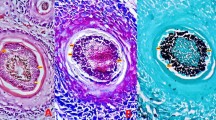Summary
We have previously reported morphological changes ofTrichophyton violaceum andMicrosporum canis in hair apparatuses in tinea capitis. To investigate the morphology ofTrichophyton rubrum in the human hair apparatus, two cases of tinea capitis and one case of tinea barbae were examined by light- and electron microscopy. The fungal elements, which were located in the lower keratogenous zone, showed non-septate hyphae in the outer part of the hair cortex. With the upward development of the hair layers, some hyphae invaded the keratinized hair cuticle and keratinized inner root sheath and were transformed into arthrospores. Some hyphae remaining in the hair cortex were also transformed into arthrospores, while other hyphae in the hair cortex did not survive, but degenerated. InT. rubrum hair infection, there is a distinct relationship between the morphological changes of the fungi and the hair cell differentiation as seen inT. violaceum andM. canis infections. However,T. rubrum displays unique morphological changes, which are different from those ofT. violaceum andM. canis, in hair apparatuses.
Similar content being viewed by others
References
Delektorski WW, Scheklakow ND, Schadyew ChK, Akyschbaewa KS, Babajan KR, Apridonidse KG (1979) Die Ultrastruktur des apikalen Segments der Hyphen mancher Dermatophyten. Mykosen 22:119–128
Edwards MR, Stevens RW (1963) Fine structure ofListeria monocytogenes. J Bacteriol 86:414–428
Fitz-James PC (1960) Participation of the cytoplasmic membrane in the growth and spore formation of bacilli. J Biophys Biochem Cytol 8:507–528
Glauert AM, Hopwood DA (1960) The fine structure ofStreptomyces coelicolor: I. the cytoplasmic membrane system. J Biophys Biochem Cytol 7:479–503
Kawata T, Inoue T (1965) Ultrastructure ofNocardia asteroides as revealed by electron microscopy. Jpn J Microbiol 9:101–114
Koike M, Takeya K (1961) Fine structures of intracytoplasmic organelles of mycobacteria. J Biophys Biochem Cytol 9:597–608
Okuda C, Ito M, Sato Y (1988) Fungus invasion into human hair tissue in black dot ringworm, light and electron microscopic study. J Invest Dermatol 90:729–733
Okuda C, Ito M, Sato Y, Oka K (1989) Fungus invasion of human hair tissue in tinea capitis caused byMicrosporum canis, light- and electron microscopic study. Arch Dermatol Res 281:238–246
Reynolds ES (1963) The use of lead citrate at high pH as an electron opaque stain in electron microscopy. J Cell Biol 17:208–212
Rippon JW (1988) Tinea capitis. In: Wonsiewicz M (ed) Medical mycology, the pathogenic fungi and the pathogenic actinomycetes, 3rd edn. WB Saunders, Philadelphia, pp 186–196
Author information
Authors and Affiliations
Rights and permissions
About this article
Cite this article
Okuda, C., Ito, M. & Sato, Y. Trichophyton rubrum invasion of human hair apparatus in tinea capitis and tinea barbae: light- and electron microscopic study. Arch Dermatol Res 283, 233–239 (1991). https://doi.org/10.1007/BF01106108
Received:
Issue Date:
DOI: https://doi.org/10.1007/BF01106108




